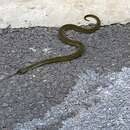pt-BR
nomes no trilho de navegação


When angered, C. lichtensteini responds by inflating the body with air, and hissing and puffing. It may then raise the forepart of the body off the ground, into a coil with the head back, and strike (Spawls et al., 2002).
Forest night adder
These snakes reach a maximum size of about 70 cm, the average size is between 30 to 55 cm. The dorsal pattern consists of green scales, which can vary between individuals from pale green to dark or olive green, and sometimes brown. Some individuals have two or three orange bars across the tail. There is sometimes a series of vague, pale-centered rhombic back markings, which may be obscured and appear as chevrons, facing forwards or backwards. The ventral scales can be yellowish, cream or pearly. The labial scales are yellow and the tongue is black with an orange band. Juveniles have a distinct white V-shape marking on the neck; this fades as they mature into a very fine V-shape, sometimes with black edging (Spawls, et al., 2002).
There are 15 scale rows at midbody, 134 to 156 ventral scales, and 14 to 23 subcaudal scales (Spawls et al., 2002).
C. lichtensteini is known to consume frogs and toads (Ineich et al., 2006).
Guinea and Liberia eastward through Ghana to Nigeria, Cameroon, Equatorial Guinea, Central African Republic, south to northern Angola, Zaire, and north-western Zambia and east to Uganda and western Kenya (McDiarmid et al., 1999).
C. lichtensteini is active mostly during the day among the shade and leaf litter of the forest floor. They swim well and have colonized islands in Lake Victoria. When inactive, they hide in holes, brush piles, tree root clusters, under ground cover and other similar nooks (Spawls et al., 2002).
Forest and woodland, swampy areas associated with forest and recently deforested areas, from 500 to 2100 m elevation.
C. lichtensteini's green colour and white V-mark on the neck make it unmistakable (Spawls et al., 2002).
Type specimen lost according to Golay et al. (1993).
Type locality: "Costa d'oro" [Gold Coast, Ghana]
Causus lichtensteinii is a viper species endemic to western, central, and eastern Africa.[2] There are no subspecies that are recognized as being valid.[3][4] Like all other vipers, it is venomous.
The specific name, or epithet, lichtensteinii, honors German herpetologist Martin Hinrich Lichtenstein.[3][5]
Common names for C. lichtensteinii include Lichtenstein's night adder,[2] forest night adder,[3][6] and olive-green viper.[7]
Adults of C. lichtensteinii average 30–55 cm (12–22 in) in length with a reported maximum of 70 cm (28 in).[2]
The head is not very wide, and the snout is blunt. The eye is surrounded by a circumorbital ring of 5–7 scales. There are 6 supralabials and 9 sublabials. The temporals number 2+3 or sometimes 2+2, with the first and second upper temporals being as long together as the first lower one. Loreals: 1+1. Midbody there are 15 rows of weakly keeled dorsal scales that have a velvety texture. The anal scale is single. There are 128–152 ventral scales. The subcaudals number 18–22 in males and 17–19 in females.[2]
The color pattern consists of a greenish or olive ground color overlaid with a series of dark narrow backward pointing chevrons running down the back. This pattern may be vague or developed fully into rhombic markings. The back of the neck has a characteristic white V-shape while the throat is black with yellow bands. Juvenile specimens are generally dark brown in color.[2]
Causus lichtensteinii is found from Guinea and Liberia eastward through Ghana to Nigeria, Cameroon, Equatorial Guinea, the Central African Republic, south to northern Angola, DR Congo and northwestern Zambia, and east to Uganda and western Kenya.[1]
The type locality is listed as "Côte- d'Or " (Gold Coast, Ghana).[8]
As opposed to other members of its genus, C. lichtensteinii is mostly found in pristine rain forests with little light filtering down to the forest floor. It tends to be found near water in swampy areas. In the Atewa Range Forest Reserve in Ghana it has been found at altitudes of up to 670 m (2,200 ft).[2]
Causus lichtensteinii is diurnal and mostly terrestrial. However, it is a good swimmer and has even colonized certain islands in Lake Victoria. When disturbed it puts on a hissing and puffing threat display similar to other members of the genus.[2]
Causus lichtensteinii is oviparous.[3]
Causus lichtensteinii is a viper species endemic to western, central, and eastern Africa. There are no subspecies that are recognized as being valid. Like all other vipers, it is venomous.